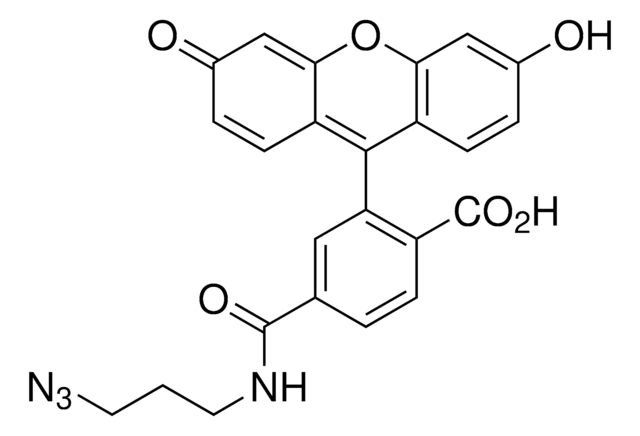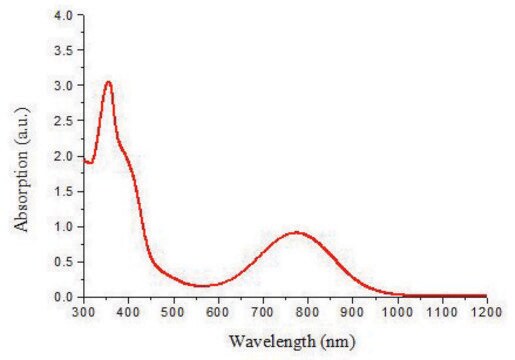72998
Atto 594 azide
BioReagent, suitable for fluorescence, ≥80.0% (HPCE)
Sign Into View Organizational & Contract Pricing
All Photos(1)
About This Item
UNSPSC Code:
12352125
NACRES:
NA.32
Recommended Products
product line
BioReagent
Quality Level
Assay
≥80.0% (HPCE)
form
solid
manufacturer/tradename
ATTO-TEC GmbH
transmittance
254 nm
604 nm
fluorescence
λex 601 nm; λem 627 nm±10 nm in 0.1 M phosphate pH 7.0
λ
in ethanol (with 0.1% trifluoroacetic acid)
suitability
suitable for fluorescence
storage temp.
−20°C
Application
Atto 594 is a novel fluorescent label belonging to the class of Rhodamine dyes. The dye is designed for application in the area of life science, e.g. labeling of DNA, RNA or proteins. Characteristic features of the label are strong absorption, high fluorescence quantum yield, high thermal and photo-stability, excellent water solubility, and very little triplet formation. After coupling to a substrate Atto 594 carries a net electrical charge of -1.
The azide modification is used in the Huisgen reaction (“Click Chemistry“).
The azide modification is used in the Huisgen reaction (“Click Chemistry“).
Legal Information
This product is for Research use only. In case of intended commercialization, please contact the IP-holder (ATTO-TEC GmbH, Germany) for licensing.
Storage Class Code
11 - Combustible Solids
WGK
WGK 3
Flash Point(F)
Not applicable
Flash Point(C)
Not applicable
Certificates of Analysis (COA)
Search for Certificates of Analysis (COA) by entering the products Lot/Batch Number. Lot and Batch Numbers can be found on a product’s label following the words ‘Lot’ or ‘Batch’.
Already Own This Product?
Find documentation for the products that you have recently purchased in the Document Library.
Semi-Solid o/w Emulsions Based on Sucrose Stearates: Influence of Oil and Surfactant Type on Morphology and Rheological Properties.
Klang, V., et al.
Journal of Dispersion Science and Technology, 34, 322-333 (2013)
Massa J Shoura et al.
Nucleic acids research, 40(15), 7452-7464 (2012-05-17)
The Cre-recombination system has become an important tool for genetic manipulation of higher organisms and a model for site-specific DNA-recombination mechanisms employed by the λ-Int superfamily of recombinases. We report a novel quantitative approach for characterizing the probability of DNA-loop
Michael R Williams et al.
The Journal of neuroscience : the official journal of the Society for Neuroscience, 32(27), 9228-9237 (2012-07-06)
The potassium channel Kv1.2 α-subunit is expressed in cerebellar Purkinje cell (PC) dendrites where its pharmacological inhibition increases excitability (Khavandgar et al., 2005). Kv1.2 is also expressed in cerebellar basket cell (BC) axon terminals (Sheng et al., 1994), where its
Our team of scientists has experience in all areas of research including Life Science, Material Science, Chemical Synthesis, Chromatography, Analytical and many others.
Contact Technical Service






